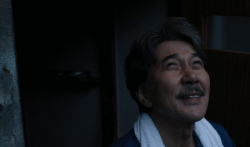All societies would like to believe that theirs is perfect, immune from instances of intolerance, prejudice and senseless violence. Nomadic Theatre’s new production of The Laramie Project is an intense look at one community’s crisis following a hate-driven murder that shattered this illusion.
On Oct. 6, 1998, Matthew Shepard, a homosexual student at the University of Wyoming, was robbed and tied to a fence where he was savagely beaten before being left to die on the side of a rural Wyoming road. Shepard’s murder and the ensuing media storm that descended upon Laramie brought this small community under the nation’s critical eye. The town of Laramie had to at once deal with both the grief that such a horrific crime engendered in their community, as well as the town’s new reputation as “Hate Crime, USA.”
As the events of that October unfolded, playwright Moises Kaufman decided to send members of his New York-based Tectonic Theater Company to Wyoming to explore an angle the media had ignored: how this tragedy affected the people of Laramie. The company members conducted interviews with residents ranging from University of Wyoming faculty to the cyclist who discovered Shepard’s body on the fence. The ensemble cast of The Laramie Project coherently ties these powerful interviews together into a moving piece of drama that teaches tolerance.
Under the skillful direction of Katie Couturier (SFS ‘05), Nomadic’s production of Laramie truly moves the audience. The actors bring an authenticity to the play that the media sensationalism surrounding the Shepherd scandal somehow missed, as these actors harness the emotion the community actually felt.
Jamaal Young (SFS ‘03) plays the doctor caring for Matthew who becomes emotionally involved in the case, as evidenced by his display of powerful emotion during the press conference. Equally moving was Paul Sciarrota’s (SFS ‘03) portrayal of the collegiate bartender, conveying sincere, strong emotion in his role as key eyewitness in the trial which is juxtaposed with Sciarrota’s other role as a fervently homophobic evangelist protesting outside Shepard’s funeral. Sarah Tarver-Wahlquist (CAS ‘03) adds another emotionally wrenching performance to the show with her portrayals of Shepard’s close friend, a lesbian, and the boy who discovered Shepard’s body.
Melissa Breiner-Sanders (CAS ‘04) adds a different angle of fear and suspense to the mix with her part as the sheriff who fears she has been exposed to HIV through contact with Shepard’s blood. She also portrays the first “out” professor at University of Wyoming, representing the reaction of the gay community in the wake of the crime. While the play generally does not focus on Matthew’s family, Graham Steele (COL ‘03) is especially moving as Dennis Shephard, Matthew’s father.
As the play includes a wide range of characters and situations in its attempt to give a fair and balanced portrayal of the reaction to the crime, a flexible set was needed to accomodate them all. Nomadic Theatre transforms the Walsh Black Box into a bar, a pulpit, a courtroom and countless other locations over the course of the show, necessitating a simple set that could be quickly and easily changed. Set Designer Caitlin Lowan’s (SFS ‘03) multi-tiered set admirably allows for this great range and flexibility.
A multimedia approach is employed in order to add to the realism of the play, with television and projection screens used to display images from around Laramie designed to heighten the emotional impact. Particularly jarring is the image of the actual fence Shepard was tied to. This use of technology is also employed to produce an abstract represantation of the media, as cast members filmed one another and the images are projected onto the screens, creating a realistic atmosphere of media chaos.
The actors’ costumes are all very similar, with everyone in the ensemble clad in matching blue dress shirts and khakis. As most of the actors were constantly on stage, there is no opportunity to change costumes, making differentiation between the many characters they portray very difficult. Costume Designer Liz Evans (SFS ‘03) remedies this problem by using accessories to distinguish between the characters. Hats, ties, coats, glasses and vests were all used (along with the actors’ accents and personal mannerisms) to give each of the numerous characters their own unique personality.
During a scene portraying an organized prayer vigil for Matthew, Father Roger Schmit of the local Catholic Church in Laramie, says, “You know what is true. You need to do your best to say it correct.” This production indeed stays true, while avoiding the trap of making Sheperd into an idol. Instead, the play gives the audience a realistic sense of what it must have felt like to be a member of the Laramie community, exposing it for what it was?an imperfect place, like every other.




